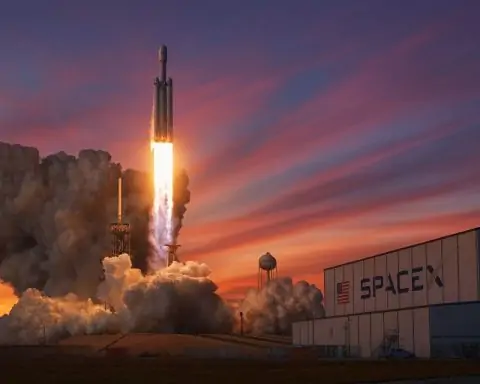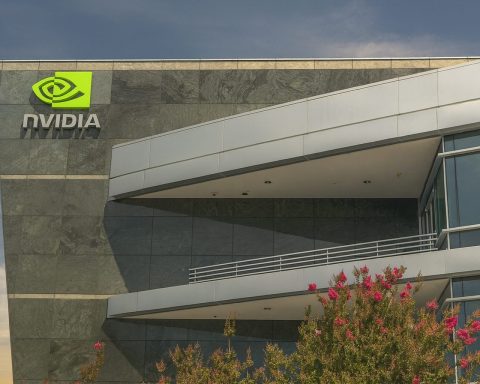SpaceX’s next Starship test (Flight 11) is set for Oct. 13, 2025 (7:15 pm ET), marking the final launch of the current “Block 2” version [1]. Flight 11 will replicate Flight 10’s profile (booster splashdown in Gulf, ship to Indian Ocean) but test new landing techniques and a reinforced heat shield [2] [3]. NASA is betting Artemis III (by ~2027) on Starship for crewed lunar landings, even as China pushes for its first moonwalk by 2030 [4] [5]. Experts warn NASA’s plan is “extraordinarily complex” [6] and may slip; former NASA chief Jim Bridenstine remarked “it doesn’t make a lot of sense… if you’re trying to go first to the moon, this time to beat China” [7]. Acting NASA boss Sean Duffy vows “we are going to win the second space race” against China [8]. SpaceX itself is booming: its Starlink network now tops ~8,500 satellites and ~$15.5 billion in annual revenue [9], driving a private valuation near $400 billion [10]. Elon Musk’s other company, Tesla (TSLA), has surged past $450, bolstered by record EV sales [11]. Space-tech stocks are hot: for example, Rocket Lab (RKLB) is up ~95% YTD at ~$50 per share [12] on its rapid launch cadence.
In-depth analysis follows below, with expert quotes and source links.
Starship Flight 11 and SpaceX’s Push
After Flight 10 on Aug. 26, which SpaceX hailed as a total success, the 400-foot Starship rocket is set for Flight 11 on Oct. 13 [13]. Like the previous flight, the Super Heavy booster (B15) will launch Ship 38 on a suborbital trajectory, deploy eight steel dummy Starlink satellites, then both stages will splash down in the ocean. Crucially, Flight 11 will incorporate upgrades: engineers have reinforced the heat shield (“crunch-wrap” felt under tiles) and will perform a novel five-engine landing burn on the booster (instead of three) to fine-tune guidance [14] [15]. SpaceX says this builds redundancy and aligns with the planned method for its next-generation Block 3 booster [16]. In space, Ship 38 will again carry missing tiles to stress-test the thermal protection, just as Flight 10 did successfully [17].
Spaceflight Now notes this is the final flight of the current Starship design, after which SpaceX will shift to an upgraded Version 3 and move operations to a new pad with a flame trench [18]. Former NASA official William Gerstenmaier says SpaceX plans “at least one suborbital flight of Starship Version 3 before attempting an orbital flight” [19]. Meanwhile, SpaceX continues to push its launch cadence: as of early October it had already completed 125 launches in 2025 [20], capturing ~87% of the commercial launch market [21]. This pace is fueled by Starlink, which now has 7,500+ operational satellites [22] and ~8 million users; SpaceX projects Starlink revenue of about $15.5 billion annually [23]. This boom underpins SpaceX’s private value (~$400 B and climbing) [24] [25].
Even SpaceX’s competitors are riding its rockets. Notably, SpaceX is launching Amazon’s Project Kuiper satellites (Starlink’s rival) – the next batch was due to launch on Oct. 8, 2025 [26]. SpaceX also dominates U.S. military launches (five new national-security contracts totaling $1.14 B, all won by SpaceX, while Blue Origin got none this round) [27]. In short, SpaceX’s launch prowess and Starlink windfall are reshaping the industry.
NASA’s Artemis vs. China’s Moon Plan
The backdrop is a Moon race. NASA’s Artemis program aims for a crewed lunar landing by mid-2027. But NASA’s current plan—built around the yet-unproven Starship—has been criticized as complex and high-risk. In CNN interviews, former NASA administrator Jim Bridenstine bluntly called NASA’s architecture “extraordinarily complex” [28] and said “It — quite frankly — doesn’t make a lot of sense if you’re trying to go first to the moon, this time to beat China.” [29] Even Doug Loverro, a former NASA human-spaceflight chief, warned that Artemis III is “incredibly hard, complex” and “likely a decade away from reality,” arguing Starship won’t be ready before the Chinese moon effort [30]. Loverro observed that NASA’s plan requires tens of Starship refueling launches to top off a depot in orbit – and pointedly noted, “Nobody knows how efficient the transfer is going to be… It’s nearly an impossible question to answer.” [31]
By contrast, China has been accelerating its lunar program. In August 2025 China successfully tested a prototype moon lander (Lanyue) that its space agency hopes will take the first Chinese astronaut to the lunar surface “before 2030.” [32]. Bill Nye of the Planetary Society echoed that urgency: “The China National Space Administration will almost certainly walk on the moon in the next five years,” he warned [33]. China’s uncrewed Chang’e missions have already made it the first nation to retrieve samples from both sides of the Moon. A crewed landing by 2030 would serve as a precursor to a Chinese-Russian lunar base by 2035 [34].
In that climate, U.S. officials are under political pressure. Acting NASA head Sean Duffy – who chaired this year’s NASA reviews – declared “I’ll be damned if the Chinese beat NASA or beat America back to the Moon. We are going to win the second space race.” [35] Congress and NASA stakeholders have been urging a 2027 landing. As Republican Sen. Ted Cruz warned, “Any drastic changes in NASA’s architecture at this stage threaten United States leadership in space.” [36] So despite worries, NASA is proceeding: Artemis III calls for multiple SLS/Orion launches and a refueled Starship lander. If all goes well, Orion will rendezvous in lunar orbit with the Starship HLS (Human Landing System) filled by dozens of tanker Starship flights [37] [38]. If NASA meets its mid-2027 goal, it would narrowly beat China’s 2030 timeline [39] [40].
Expert Opinions: Confidence vs. Caution
SpaceX’s success in rapid development inspires confidence in some quarters. Flight-test observers like Olivier de Weck (MIT Apollo program professor) praised August’s Flight 10 as near-perfect: “I would give [Flight 10] an A-plus… I don’t think this could have gone much better,” he said [41]. He added that the next big step is an upright landing of Starship itself on the pad, which SpaceX will attempt in future tests. Former White House space adviser Greg Autry likewise is generally bullish, saying SpaceX “is headed in the right direction” and noting that Musk “tends to prove critics wrong in the long run” (citing past promises like self-driving cars eventually delivering) [42].
Others stress stakes and history. Autry and others compare the space race to the Age of Exploration – countries that harness space will “dominate human history,” he said [43] [44]. Autry pointed out the long-term payoffs: innovations from the original Apollo era (computing, AI, Internet, etc.) largely stemmed from space-investments [45]. That helps justify billions in spending today on Starship and Artemis.
On the flip side, former NASA officials argue that NASA is gambling. Loverro, who quit NASA in 2019, said “NASA’s decision to use Starship as the lunar lander… was made in error.” He thinks SpaceX will eventually succeed, but warned flatly that Starship won’t be ready to land astronauts before China, “no way,” given current schedules [46]. Even an internal NASA review (the Aerospace Safety Advisory Panel) has sounded the alarm: engineer Paul Hill testified the Starship timeline is “significantly challenged” and “years late” for the 2027 landing [47]. Yet the panel acknowledged SpaceX’s strengths, praising its “full combination of factors” and culture of innovation [48] [49].
In sum, space experts are divided but agree that Friday’s test is critical. If Flight 11 goes well – testing booster precision burns and reaffirming Ship’s re-entry toughness – it will reinforce hopes that Starship can evolve into a reliable crewed lander [50] [51]. But if new failures occur, it would underscore the challenge of meeting NASA’s timeline. As one analyst put it, NASA is “really at step one of the 12-step process of figuring out we have a problem” in relying on an unproven super-rocket [52].
Market Impact: Musk & Space-Industry Stocks
SpaceX itself is private, but Elon Musk’s high-profile role and the space boom are rippling through the markets. Tesla (NASDAQ: TSLA), which Musk also runs, climbed sharply in early October. On Oct 6 TSLA jumped over 5% to about $453 [53], fueled by Tesla’s record Q3 deliveries (nearly 497,100 EVs shipped [54]) and teases of a cheaper Model Y variant [55]. As of Oct 7, TSLA traded in the mid-$450s, giving Tesla a ~$1.5 trillion market cap [56]. Tesla’s blowout sales put some analysts on alert: portfolio manager Elliot Johnson warned he’s “skeptical that this will be sustainable” after tax-credit-driven demand spikes [57]. But many Wall Street bulls remain upbeat on Tesla’s long-term growth (one Morgan Stanley analyst has a $410 price target [58], and some even see $500–$600) despite critics noting Tesla now trades at ~250× earnings [59]. Tesla’s stock boom is yet another sign of Musk’s sway – his $465 billion personal net worth owes much to Tesla’s moves [60], even as he juggles SpaceX and Twitter.
Outside Musk’s companies, some public “space” stocks have zoomed as the industry heats up. For example, Rocket Lab (NASDAQ: RKLB) is up roughly 95% year-to-date, trading near $50 [61], after securing big launch contracts (including 21 satellites to Japan’s Synspective [62]) and flying the first twin interplanetary probes to Mars [63]. Its rapid launch cadence (over 20 missions slated for 2025) and new government contracts have Wall Street analysts largely bullish, with a consensus “Strong Buy” and average target ~$50 [64]. However, they caution Rocket Lab’s valuation is steep (P/S ~50-60×) and it has yet to turn a profit [65].
Investors can also get indirect exposure to SpaceX itself via certain funds. Though SpaceX shares aren’t public, a number of ETFs and trusts hold SpaceX stock on secondary markets [66]. (Tech-stock funds like ARK’s XOVR or Baron Partners have disclosed SpaceX stakes [67].) SpaceX is riding an aggressive growth curve: Musk says the company aims for over $15 billion in revenue in 2025 [68] as it targets ~170 missions and expands Starlink. Industry legend Ron Baron projects SpaceX could reach $500 billion in value by 2030 [69].
Other aerospace stocks (e.g. Boeing, Lockheed Martin) are more tied to government programs. Boeing (ticker BA) still supplies NASA’s Artemis rockets (SLS core stage) and runs ISS operations, but it faces delays and budget pressures. Blue Origin (private, backed by Amazon’s Jeff Bezos) trails behind; its stock isn’t public, but its parent Amazon (AMZN) trades around $216 [70]. (Forecast services see Amazon in the low-$200s this month, with growth expected by 2026 [71].) Overall, the space industry is attracting record investment (a recent report noted $3.5 billion poured into space ventures in 2025 [72]) and analysts view it as a new tech frontier, blending launches, satellite broadband, and even space tourism in the years ahead.
What Comes Next?
As Oct. 13 approaches, all eyes in the space community will be on Boca Chica to see if Starship can nail this high-stakes test. Success would keep SpaceX on track for its next milestones (vertical landing attempts, orbital flight tests) and help reassure NASA it chose wisely. Failure, however, would fuel skepticism at a critical juncture. In Congress, presidential campaigns and boardrooms, leaders are thinking big: NASA emphasizes that Artemis’s goal is not just a flag on the Moon, but a sustainable presence [73]. In markets, investors will watch Musk’s moves and how space projects influence tech earnings. For now, experts stress that the outcome of this giant rocket’s next hop could steer the future of lunar exploration and the space industry for the next decade [74] [75].
Sources: Coverage from CNN and ABC News (Oct 2025) [76] [77], Space.com and Spaceflight Now (Oct 2025) [78] [79], Reuters reporting on Tesla, China and space policy [80] [81], and TechStock² (TS2.tech) analyses [82] [83]. Expert quotes and data are cited above from these sources. All stock prices and forecasts cited are current as of mid-Oct 2025.
References
1. ts2.tech, 2. ts2.tech, 3. www.space.com, 4. www.krgv.com, 5. www.reuters.com, 6. www.krgv.com, 7. www.krgv.com, 8. abcnews.go.com, 9. ts2.tech, 10. ts2.tech, 11. ts2.tech, 12. ts2.tech, 13. ts2.tech, 14. ts2.tech, 15. www.space.com, 16. ts2.tech, 17. ts2.tech, 18. spaceflightnow.com, 19. spaceflightnow.com, 20. ts2.tech, 21. ts2.tech, 22. ts2.tech, 23. ts2.tech, 24. ts2.tech, 25. ts2.tech, 26. ts2.tech, 27. ts2.tech, 28. www.krgv.com, 29. www.krgv.com, 30. www.krgv.com, 31. www.krgv.com, 32. www.reuters.com, 33. www.krgv.com, 34. www.reuters.com, 35. abcnews.go.com, 36. www.krgv.com, 37. www.krgv.com, 38. www.krgv.com, 39. www.krgv.com, 40. www.reuters.com, 41. abcnews.go.com, 42. abcnews.go.com, 43. abcnews.go.com, 44. abcnews.go.com, 45. abcnews.go.com, 46. www.krgv.com, 47. www.krgv.com, 48. www.krgv.com, 49. www.krgv.com, 50. ts2.tech, 51. www.space.com, 52. www.krgv.com, 53. ts2.tech, 54. www.reuters.com, 55. ts2.tech, 56. ts2.tech, 57. www.reuters.com, 58. ts2.tech, 59. ts2.tech, 60. ts2.tech, 61. ts2.tech, 62. ts2.tech, 63. ts2.tech, 64. ts2.tech, 65. ts2.tech, 66. ts2.tech, 67. ts2.tech, 68. ts2.tech, 69. ts2.tech, 70. longforecast.com, 71. longforecast.com, 72. www.reuters.com, 73. www.krgv.com, 74. www.krgv.com, 75. ts2.tech, 76. www.krgv.com, 77. abcnews.go.com, 78. www.space.com, 79. ts2.tech, 80. www.reuters.com, 81. www.reuters.com, 82. ts2.tech, 83. ts2.tech










